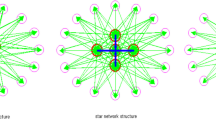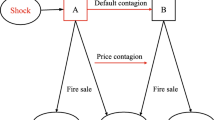Abstract
Using the unique data set of all the transactions with trade credit via 17 major banks in Korea during 2008–2012, we investigate the relationship between the network structure and the contagion of failures in the financial network. Due to the difference of terms between two types of trade credits in Korea, Account Receivable Financing and Supplier Loan, a non-trivial directed network of banks and firms can be formulated. With respect to this trade credit network (TCN), we propose a measure for systemic risk on liquidity channels by calculating the monthly potential risk of liquidity shortage in the worst-case scenarios and show some comparisons with the basic network characteristics. Results claim that the PageRank centralities of individual banks have significant positive impact on the level of systemic risk. More on, degrees of nodes in TCN follows power-law distributions and the network heterogeneity of given month also has significant positive impact on the risk level: that is, the high degree of imbalance in the liquidity channel implies the severe systemic shortage of the liquidity in the worst-case.










Similar content being viewed by others
Notes
This centrality is suggested by Page et al. (1998) and widely used in the network analysis.
A common shock magnifies the correlation between financial conditions of trade creditor and trade debtor. And credit debtors having bad credits tend to match with the trade creditors which have bad credit ratings also. More on, the default of trade creditor may cause the debtors to fail by contracting trade credit supply.
According to our data set, 60.12% (6,612,839 contracts among 11,000,189 cases) are classified as risky. Since firms use installment payments, only 0.95% (104,491 cases) of the risky TCs have full bank balances, which means that the debtor never repays the debt.
We can deduce this statement indirectly from our data. On average, 90.3% of the contract pairs (buyer-seller pairs) reappear in the data. This means that the most of remaining debts are handled within the on-going partnerships.
A power-law distribution has a density function of following form: \({p(x)=\frac{\alpha -1}{x_{min}}\big (\frac{x}{x_{min}}\big )^{-\alpha }}\) The parameter \(\alpha \) is called a scale parameter and represents the slope of density function in a semi-log graph.
The number of firms which are categorized into the statutorily audited firm in the total data is 11,520. And the number of the other firms are 361,086. However, the number of contracts related to the former type of firms is 3,788,280, while the number of contracts not related to them is 7,211,909.
Clauset et al. (2009) provided the open access to their Matlab codes for power-law test. Log-likelihood ratio tests were conducted and results were significant. For lack of space, test results are omitted.
Chi-square statistics of Hausman test for the Eq. (1) was 9.75 and p-value was 0.0076.
Chi-square statistics of Hausman test for the Eq. (2) was 3.55 and p-value was 0.1694.
Chi-square statistics of Hausman test for the Eq. (3) was 0.02 and p-value was 0.8875.
References
Acemoglu, Daron, Carvalho, Vasco M, Ozdaglar, Asuman, & Tahbaz-Salehi, Alireza. (2012). The network origins of aggregate fluctuations. Econometrica, 80(5), 1977–2016. doi:10.3982/ECTA9623. ISSN 0012-9682.
Acemoglu, Daron, Ozdaglar, Asuman, & Tahbaz-Salehi, Alireza. (2015). Systemic risk and stability in financial networks. American Economic Review, 105(2), 564–608. doi:10.1257/aer.20130456. ISSN 0002-8282.
Acharya, V. V., Pedersen, L. H., Philippon, Thomas, & Richardson, M. P. (2010). Measuring systemic risk. Retrieved from http://papers.ssrn.com/sol3/papers.cfm?abstract_id=1595075.
Adrian, Tobias, & Brunnermeier, M. k. (2014). CoVaR. Federal Reserve Bank of New York Staff Reports. Retrieved September 2014, from http://www.nber.org/papers/w17454.
Battiston, S., Puliga, M., Kaushik, R., Tasca, P., & Caldarelli, G. (2012). Too central to fail? Financial networks, the FED and systemic risk. Scientific Reports, 2, 1–6. doi:10.1038/srep00541. ISSN 2045-2322.
Biais, B., & Gollier, C. (1997). Trade credit and credit rationing. The Review of Financial Studies, 10(4), 903–937.
Billio, M., Getmansky, M., Lo, A. W., & Pelizzon, L. (2012). Econometric measures of connectedness and systemic risk in the finance and insurance sectors. Journal of Financial Economics, 104(3), 535–559. doi:10.1016/j.jfineco.2011.12.010. ISSN 0304405X.
Bisias, D., Flood, M., Lo, A. W., & Valavanis, S. (2012). A Survey of Systemic Risk Analytics. Annual Review of Financial Economics, 4(1), 255–296. doi:10.1146/annurev-financial-110311-101754. ISSN 1941-1367.
Burkart, M., & Ellingsen, T. (2004). In-kind finance: A theory of trade credit. American Economic Review, 94(3), 569–590. doi:10.1257/0002828041464579. ISSN 00028282.
Chen, S. C., Teng, J. T., & Skouri, K. (2012). Economic production quantity models for deteriorating items with up-stream full trade credit and down-stream partial trade credit. International Journal of Production Economics, 155, 302–309. doi:10.1016/j.ijpe.2013.07.024. ISSN 09255273.
Choromanski, K., Matuszak, M., & Miekisz, J. (2013). Scale-free graph with preferential attachment and evolving internal vertex structure. Journal of Statistical Physics, 151(6), 1175–1183. doi:10.1007/s10955-013-0749-1. ISSN 0022-4715.
Clauset, A., & Shalizi, C. R. (2009). Power-law distributions in empirical data. SIAM Review, 51(4), 661–703. doi:10.1137/070710111. ISSN 00361445.
Elliot, M., Golub, B., & Jackson, M. (2014). Financial networks and contagion. American Economic Review, 104(10), 3115–3153. ISSN 1556-5068.
Estrada, Ernesto. (2010). Quantifying network heterogeneity. Physical Review E, 82(6), 066102. doi:10.1103/PhysRevE.82.066102. ISSN 1539-3755.
Giesecke, K., & Kim, B. (2013). Systemic risk: What defaults are telling us. Management Science, 57(8), 1387–1405. ISSN 0025-1909.
Gabaix, X. (2011). The granular origins of aggregate fluctuations. Econometrica, 79(3), 733–772. ISSN 0012-9682.
Giesecke, K., & Kim, B. (2011). Systemic risk: What defaults are telling us. Management Science, 57(8), 1387–1405. ISSN 0025-1909.
Huang, X., Zhou, H., & Zhu, H. (2009). A framework for assessing the systemic risk of major financial institutions. Journal of Banking & Finance, 33(11), 2036–2049. doi:10.1016/j.jbankfin.2009.05.017. ISSN 03784266.
Jacobson, T., & von Schedvin, E. (2015). Trade credit and the propagation of corporate failure: An empirical analysis. Econometrica, 83(4), 1315–1371. doi:10.3982/ECTA12148. ISSN 0012-9682.
Onnela, J.-P., Saramäki, J., Hyvönen, J., Szabó, G., Lazer, D., Kaski, K., et al. (2007). Structure and tie strengths in mobile communication networks. Proceedings of the National Academy of Sciences of the United States of America, 104(18), 7332–7336. doi:10.1073/pnas.0610245104. ISSN 0027-8424.
Page, Lawrence, Brin, Sergey, Motwani, Rajeev, & Winograd, Terry (1998). The PageRank citation ranking: Bringing order to the web. Technical report. Retrieved from http://ilpubs.stanford.edu:8090/422.
Peterson, M. A., & Rajan, R. C. (1997). Trade credit: Theories and evidence. Review of Financial Studies, 10(3), 661–691. doi:10.1093/rfs/10.3.661. ISSN 08939454.
Smith, J. K. (1987). Trade credit and informational asymmetry. The Journal of Finance, 42(4), 863–872. ISSN 00221082.
Vodenska, Irena, Aoyama, Hideaki, Fujiwara, Yoshi, & Iyetomi, Hiroshi (2014). Interdependencies and causality in coupled financial networks. Reterieved from http://papers.ssrn.com/sol3/papers.cfm?abstract_id=2477242.
Wilner, Benjamin S. (2000). The exploitation of relationships in financial distress : The case of trade credit. The journal of Finance, 55(1), 153–178. doi:10.1111/0022-1082.00203. ISSN 00221082.
Acknowledgements
This work was supported by the National Research Foundation of Korea Grant funded by the Korean Government(2014S1A3A2044459). We thank Dain Jung from KAIST who helped us with the data preprocessing and two anonymous reviewers who provided insights that greatly assisted the research.
Author information
Authors and Affiliations
Corresponding author
Rights and permissions
About this article
Cite this article
Lee, J., Lee, D.H. & Yun, SG. Systemic Risk on Trade Credit Systems: with the Tangible Interconnectedness. Comput Econ 51, 211–226 (2018). https://doi.org/10.1007/s10614-016-9632-x
Accepted:
Published:
Issue Date:
DOI: https://doi.org/10.1007/s10614-016-9632-x




